
Een overzicht van de kernwoorden over het verkeer. Hier kunt u gemakkelijk kernwoorden en definities opzoeken die u nog niet kent.
More subjects
Khachapuri (Georgian: ხაჭაპური khach’ap’uri [χɑtʃʼɑpʼuɾi] from Georgian: ხაჭო Georgian pronunciation: [χatʃʼo] 'curds' + Georgian: პური Georgian pronunciation: [pʼuri] 'bread') is a traditional Georgian dish of cheese-filled bread. The bread is leavened and allowed to rise, molded into various shapes, and then filled in the center with a mixture of cheese (fresh or aged, most commonly, specialized Khachapuri cheese), eggs, and other ingredients. The bread crust is traditionally torn off and dipped into the cheese. It is very popular in Georgia, both in restaurants and as street food. As a Georgian staple food, the price of making khachapuri is used as a measure of inflation in different Georgian cities by the 'khachapuri index,' developed by the International School of Economics at Tbilisi State University. It is Georgia's national dish, inscribed on the list of the intangible cultural heritage of Georgia. On the behalf and initiative of the Gastronomic Association of Georgia, the 27th of February was announced as National Khachapuri Day, to celebrate Georgia's signature pastry as well as to promote its recognition internationally. (Source: Wikipedia.org, CC BY-SA)
Bratwurst (German: [ˈbʁaːtvʊʁst] ) is a type of German sausage made from pork or, less commonly, beef or veal. The name is derived from the Old High German Brätwurst, from brät-, finely chopped meat, and Wurst, sausage, although in modern German it is often associated with the verb braten, to pan fry or roast. Beef and veal are usually incorporated amongst a blend often including pork. Recipes for the sausage vary by region and even locality; some sources list over 40 different varieties of German bratwurst, many of the best known originating in Franconia (today for the most part situated in northern Bavaria, but still culturally quite distinct), its northern neighbour Thuringia and adjacent areas. How the sausages are served is also locally different, but most commonly they are regarded as a simple snack served with or in a white bread roll made from wheat flour and eaten with mustard. As a pub dish, it is often accompanied by sauerkraut or potato salad and sometimes served with dark, crusty country bread made predominantly from rye flour, less commonly with a Brezel (pretzel). It is a very popular form of fast food in German-speaking countries, often cooked and sold by street vendors from small stands, and is also traditionally popular with fans at football games. (Source: Wikipedia.org, CC BY-SA)
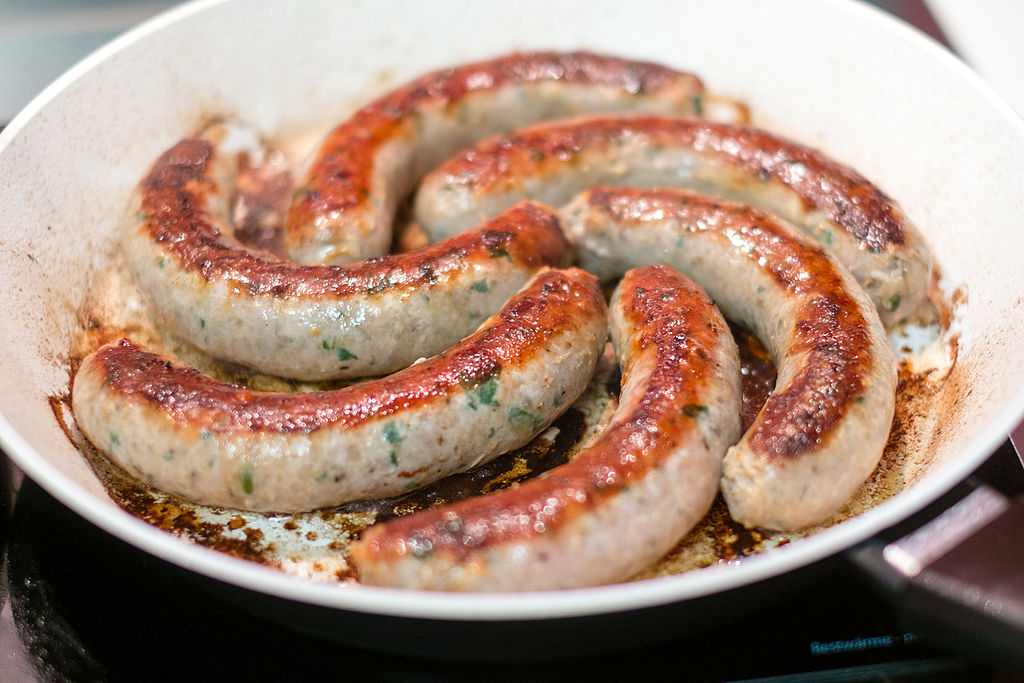 © Wikimedia.org/Alice Wiegand, CC BY-SA
© Wikimedia.org/Alice Wiegand, CC BY-SA
Currywurst (German: [ˈkœʁiˌvʊɐ̯st] ) is a fast food dish of German origin consisting of steamed, fried sausage, usually pork (German: Bratwurst), typically cut into bite-sized chunks and seasoned with curry ketchup, a sauce based on spiced ketchup or tomato paste topped with curry powder, or a ready-made ketchup seasoned with curry and other spices. The dish is often served with chips. The invention of currywurst is attributed to Herta Heuwer in Berlin in 1949, after she obtained ketchup (or possibly Worcestershire sauce) and curry powder from British soldiers in Germany. She mixed these ingredients with other spices and poured it over grilled pork sausage. Heuwer started selling the cheap but filling snack at a street stand in the Charlottenburg district of Berlin, where it became popular with construction workers rebuilding the devastated city. (Source: Wikipedia.org, CC BY-SA)
Eisbein (literally: 'ice bone') is a German culinary dish of corned ham hock, usually cured and slightly boiled. The name originates from the practice of using the pig's leg bone for ice skating. In Southern parts of Germany, the common preparation is known as Schweinshaxe, and it is usually roasted. The Polish dish golonka or golonko and Swedish dish fläsklägg med rotmos are very similar, alternatively grilled on a barbecue; another similar dish is the Swiss Wädli and the Austrian Stelze. Eisbein is usually sold already cured and sometimes smoked, and then used in simple hearty dishes. Numerous regional variations exist, for example in Berlin it is served with pease pudding. In Franconia, Eisbein is commonly served with mashed potatoes or sauerkraut, in Austria with horseradish and mustard instead. (Source: Wikipedia.org, CC BY-SA)
Sauerbraten is a traditional German roast of heavily marinated meat. It is regarded as a national dish of Germany, and is frequently served in German-style restaurants internationally. It can be prepared from a variety of meats, most often from beef, but also from venison, lamb and mutton, pork and horse. Before cooking, the raw meat is marinated for three to ten days in a mixture of vinegar or wine, water, herbs, spices, and seasonings. Usually, tougher cuts of meat, such as rump roast or bottom round of beef, are used, and the long marinating tenderizes the meat. A Sauerbraten dinner is almost always accompanied by a hearty gravy resulting from its roasting and is most often served with potato pancakes (Kartoffelpuffer), potato dumplings (Kartoffelklöße), or Spätzle. (Source: Wikipedia.org, CC BY-SA)
Sauerkraut (/ˈsaʊ.ərkraʊt/; German: [ˈzaʊɐˌkʁaʊt] , lit. 'sour cabbage') is finely cut raw cabbage that has been fermented by various lactic acid bacteria. It has a long shelf life and a distinctive sour flavor, both of which result from the lactic acid formed when the bacteria ferment the sugars in the cabbage leaves. It is one of the best-known national dishes in Germany. Although in English-speaking countries it is known under its German name, it is also a traditional and ubiquitous dish in Eastern Europe. Sauerkraut is made by a process of pickling called lactic acid fermentation that is analogous to how traditional (not heat-treated) pickled cucumbers and kimchi are made. The cabbage is finely shredded, layered with salt, and left to ferment. Fully cured sauerkraut keeps for several months in an airtight container stored at 15 °C (60 °F) or below. Neither refrigeration nor pasteurization is required, although these treatments prolong storage life. (Source: Wikipedia.org, CC BY-SA)
A schnitzel is a thin slice of meat. The meat is usually thinned by pounding with a meat tenderizer. Most commonly, the meat is breaded before frying. Breaded schnitzel is popular in many countries and is made using veal, pork, chicken, mutton, beef, or turkey. Schnitzel is very similar to the dish escalope in France and Spain, panado in Portugal, tonkatsu in Japan, cotoletta in Italy, kotlet schabowy in Poland, milanesa in Latin America, chuleta valluna in Colombia, and chicken-fried steak and pork tenderloin of the United States. (Source: Wikipedia.org, CC BY-SA)
Schweinshaxe (German pronunciation: [ˈʃvaɪns.haksə]), in German cuisine, is a roasted ham hock (or “pork knuckle”). The ham hock is the end of the pig's leg, just above the ankle and below the meaty ham portion. It is especially popular in Bavaria as Schweinshaxn [ˈʃvaɪns.haksn̩] or Sauhax(n) [ˈsaohaks(n̩)]. A variation of this dish is known in parts of Germany as Eisbein, in which the ham hock is pickled and usually slightly boiled. Schweinshaxe is one of the formerly typical peasant foods, in which recipes were composed to make inexpensive and tough cuts of meat more palatable (see, for beef, the popular Sauerbraten). Such inexpensive cuts usually require long periods of preparation. The meat is sometimes marinated for days, and in the case of big cuts up to a week. The Schweinshaxe is then roasted at low temperatures, typically—depending on size—for two to three hours. The most popular side dishes are potatoes and cabbage variations. (Source: Wikipedia.org, CC BY-SA)
Fasolada (Greek: φασολάδα) or fasoulada (Greek: φασουλάδα) is a Greek, Mediterranean, and Cypriot soup of dry white beans, olive oil, and vegetables. It is sometimes called the 'national food of the Greeks'. Fasolada is made by simmering beans with tomatoes and other vegetables such as carrots, onion, parsley, celery, and bay leaf. Lima beans are sometimes used instead of white beans. Recipes vary considerably, often including meat like bastırma and olive oil. (Source: Wikipedia.org, CC BY-SA)
Gyros, anglicized as a gyro (/ˈjɪəroʊ, ˈdʒɪər-, ˈdʒaɪr-/; Greek: γύρος, romanized: yíros/gyros, lit. 'turn', pronounced [ˈʝiros]) in some regions, is meat cooked on a vertical rotisserie (similar to Doner kebab), then sliced and served wrapped or stuffed in pita bread, along with other ingredients such as tomato, onion, fried potatoes, and tzatziki. In Greece, it is normally made with pork or sometimes with chicken, whilst beef and lamb are also used in other countries. In Greece, gyros is normally made with pork, though other meats are used in other countries. Chicken is common, and lamb or beef may be found more rarely.[citation needed] Typical American mass-produced gyros are made with finely ground beef mixed with lamb. (Source: Wikipedia.org, CC BY-SA)
Greek salad or horiatiki salad (Greek: χωριάτικη σαλάτα or θερινή σαλάτα) is a popular salad in Greek cuisine generally made with pieces of tomatoes, cucumbers, onion, feta cheese (usually served as a slice on top of the other ingredients), and olives (typically Kalamata olives) and dressed with salt, Greek oregano, and olive oil. Common additions include green bell pepper slices or caper berries (especially on the Dodecanese islands). Greek salad is often imagined as a farmer's breakfast or lunch, as its ingredients resemble those that a Greek farmer might have on hand. (Source: Wikipedia.org, CC BY-SA)
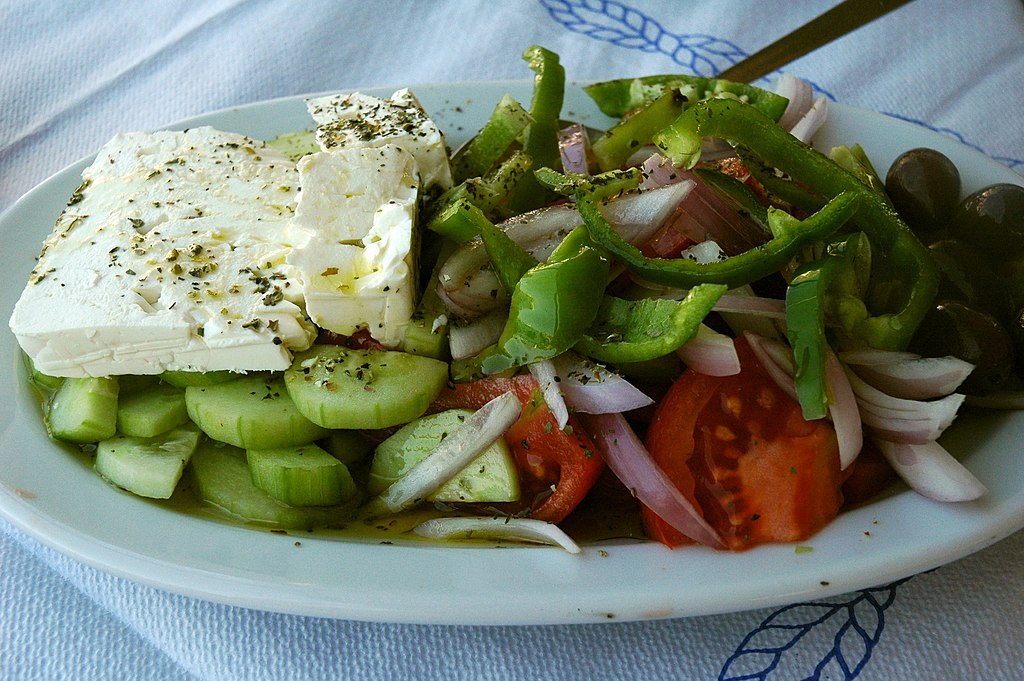 © Wikimedia.org/Jpatokal, CC BY-SA
© Wikimedia.org/Jpatokal, CC BY-SA
Magiritsa (Greek: μαγειρίτσα) is a Greek soup made from lamb offal, associated with the Easter (Pascha) tradition of the Greek Orthodox Church. Accordingly, Greek-Americans and Greek-Canadians sometimes call it 'Easter soup', 'Easter Sunday soup', or 'Easter lamb soup'. In some parts of Greece, most notably Thessaly, it is not served as soup but rather as a fricassee, where it contains only offal and large variety of vegetables, but no onions or rice, as in the soup. While traditional magiritsa includes all the lamb offal available, it is the head and neck of the lamb which provide most of the soup's flavor, and those parts, along with the intestines, heart, and liver, are most commonly used today. After a thorough cleaning, the lamb parts are boiled whole in water for between thirty minutes and two hours, then cut up into smaller pieces, flavored with onions, dill, butter[citation needed] and sometimes vegetables, and left to simmer. Rice is added towards the end of the boiling process, and the stock is thickened with avgolemono. (Source: Wikipedia.org, CC BY-SA)
Moussaka (/muːˈsɑːkə/, UK also /ˌmuːsəˈkɑː/, US also /ˌmuːsɑːˈkɑː/) is an eggplant- or potato-based dish, often including ground meat, which is common in the Balkans and the Middle East, with many local and regional variations. The best-known version in Europe and the Americas is the Greek variant created in the 1920s by Nikolaos Tselementes. Many versions have a top layer made of milk-based sauce thickened with egg (custard) or flour (béchamel sauce). In Greece, the dish is layered and typically served hot. Tselementes also proposed a vegan variant for orthodox fast days. Romania also has a vegan version that replaces meat with mushrooms or a mix of sautéed onions and rice. (Source: Wikipedia.org, CC BY-SA)
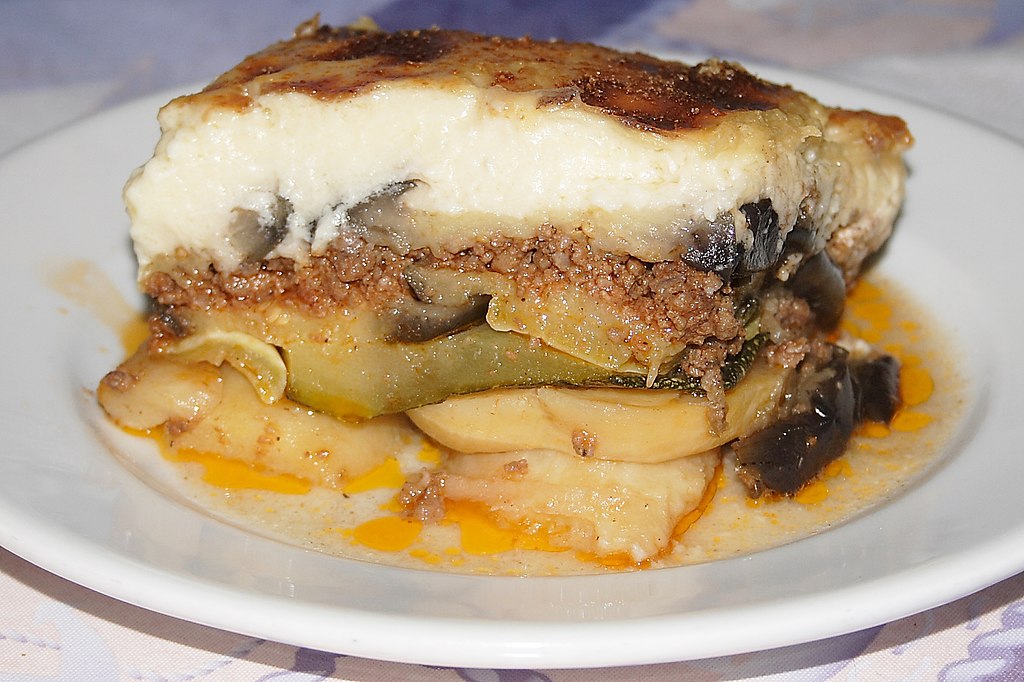 © Wikimedia.org/Robert Kindermann, CC BY-SA
© Wikimedia.org/Robert Kindermann, CC BY-SA
Souvlaki (Greek: σουβλάκι, souvláki, [suˈvlaci]; plural: σουβλάκια, souvlákia), is a popular Greek fast food consisting of small pieces of meat and sometimes vegetables grilled on a skewer. It is usually eaten straight off the skewer while still hot. It can be served with or inside a rolled pita, typically with lemon, sauces, vegetables such as sliced tomato and onion, and fried potatoes as a side. The meat usually used in Greece and Cyprus is pork, although chicken, beef, and lamb may also be used in some regions as well as worldwide. (Source: Wikipedia.org, CC BY-SA)
Oil down is a salted meat and vegetable stew that is the national dish of Grenada. Oil down is a stew of breadfruit, salted meat, chicken, dumplings, callaloo, and other vegetables stewed in coconut milk, herbs, and spices. The name refers to the fact that the oil from the coconut milk used in cooking is either absorbed by the ingredients or settles to the bottom of the cooking pot. All of the liquid is cooked down (dried out), hence the name oil down. The term 'oil down' is also used for a traditional neighborhood party at which the stew is prepared and eaten. Traditionally it is the men who cook the oil down at such parties. Oil down is also very popular in local restaurants. (Source: Wikipedia.org, CC BY-SA)
Pepián is a thick meat stew from Guatemala. It is one of the oldest and most recognizable dishes of Guatemalan cuisine having as its origin the influences from Guatemala's colonial past and the indigenous cuisine. The meat-based stew, thickened with gourd seeds, can be made with beef or chicken (beef is more common in urban centers) it includes in traditional recipes tomatillo, tomato and hot chili. Guatemalan restaurants in the United States usually consider the dish to be of Maya origin. It is a popular street food in Guatemalan cities. In Guatemala it is considered a national dish. Pipián is a similar dish from Mexican cuisine. (Source: Wikipedia.org, CC BY-SA)
Pepperpot is an Amerindian-derived dish popular in Guyana. It is traditionally served at Christmas and other special events. Along with chicken curry, and cook-up rice, pepperpot is one of Guyana's national dishes. Pepperpot is a stewed meat dish, strongly flavoured with cinnamon, cassareep (a special sauce made from the cassava root) and other basic ingredients, including Caribbean hot peppers. Beef, pork, and mutton are the most popular meats used, though some have been known to use chicken. Pepperpot is popularly served with a dense Guyanese-style homemade or home-style bread, rice, or roti. It can also be served with boiled vegetables such as cassava, eddoes, sweet potatoes, and green or ripe plantains. (Source: Wikipedia.org, CC BY-SA)
Griot (French: griot, Haitian Creole: griyo) is a dish in Haitian cuisine. It consists of pork shoulder marinated in citrus, which is braised and then fried. It is commonly served at parties. Griot along with diri ak pwa wouj (red beans and rice) is considered by some to be Haiti's 'national dish.' Griot is usually made from pork shoulder. The meat is first washed then put in a mixture of citrus juices to add flavor. After being soaked in the citrus juices, the meat is marinated in epis, which is a mixture of Haitian herbs, vegetables, and spices. Next, the meat is either braised or roasted until tender. The cooking liquid produced is used in the preparation of an accompanying sauce, known as sòs ti-malis. Finally, the meat is deep-fried until golden-brown and crispy. Griot is almost always served with pikliz as well as rice or bannann peze. (Source: Wikipedia.org, CC BY-SA)
Soup joumou (/dʒuːmuː/; French: soupe au giraumon) is a soup native to Haitian cuisine. In 2021, soup joumou was added to the UNESCO Intangible Cultural Heritage List. The soup is traditionally cooked with winter squashes such as the turban squash. The squash slices are simmered in a saucepan along with pieces of beef and soup bones, potato, and vegetables such as malanga, leeks, celery, radishes, carrots, green cabbage, habanero pepper and onions. The squash is then puréed, usually in a food processor, with water and the purée is returned to the saucepan. Salt and seasoning along with lime juice, garlic, parsley and other herbs and spices are then added. Some Haitians add thin pasta such as vermicelli and macaroni and a small amount of butter or oil. The soup is always served hot and is usually accompanied with sliced bread which is dipped in the soup. (Source: Wikipedia.org, CC BY-SA)
A baleada (Spanish pronunciation: [baleˈaða]) is a traditional Central American dish, believed to have originated on the northern coast of Honduras.[citation needed] It is composed of a flour tortilla, filled with a smear of mashed 'refried' red beans (a variety of bean native to Central and South America), crema (mantequilla blanca), and crumbled queso duro (salty hard cheese). This is usually called baleada sencilla (simple baleada). Other ingredients may include scrambled eggs, avocados, meat, or plantains. (Source: Wikipedia.org, CC BY-SA)
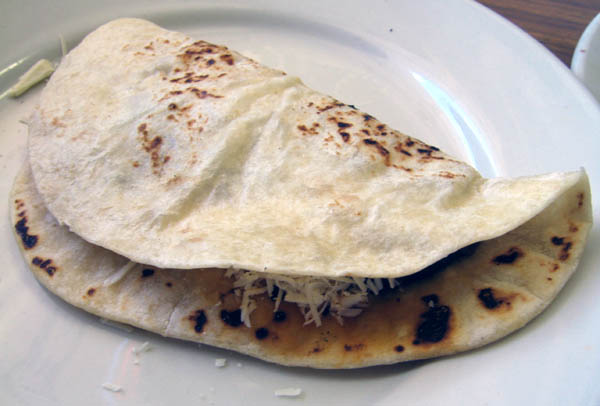 © Wikimedia.org/Ipaz0185, CC BY-SA
© Wikimedia.org/Ipaz0185, CC BY-SA
Goulash (Hungarian: gulyás) is a soup or stew of meat and vegetables seasoned with paprika and other spices. Originating in Hungary, goulash is a common meal predominantly eaten in Central Europe but also in other parts of Europe. It is one of the national dishes of Hungary and a symbol of the country. Its origin may be traced back as far as the 10th century, to stews eaten by Hungarian shepherds. At that time, the cooked and flavored meat was dried with the help of the sun and packed into bags produced from sheep's stomachs, needing only water to make it into a meal. Earlier versions of goulash did not include paprika, as it was not introduced to Europe until the 16th century. (Source: Wikipedia.org, CC BY-SA)
Hákarl (an abbreviation of kæstur hákarl Icelandic pronunciation: [ˈcʰaistʏr ˈhauːˌkʰa(r)tl̥], referred to as fermented shark in English) is a national dish of Iceland consisting of a Greenland shark or other sleeper shark that has been cured with a particular fermentation process and hung to dry for four to five months. It has a strong ammonia-rich smell and fishy taste, making hákarl an acquired taste. Fermented shark is readily available in Icelandic stores and may be eaten year-round, but is most often served as part of a þorramatur, a selection of traditional Icelandic food served at the midwinter festival þorrablót. (Source: Wikipedia.org, CC BY-SA)
Gado-gado (Indonesian or Betawi) is an Indonesian salad of raw, slightly boiled, blanched or steamed vegetables and hard-boiled eggs, boiled potato, fried tofu and tempeh, and lontong (rice wrapped in a banana leaf), served with a peanut sauce dressing. In 2018, gado-gado was promoted as one of five national dishes of Indonesia; the others are soto, sate, nasi goreng, and rendang. Gado-gado is widely sold in almost every part of Indonesia, with each area having its own modifications. It is thought to have originally been a Sundanese dish, as it is most prevalent in Western parts of Java (which includes Jakarta, Banten, and West Java provinces). The Javanese have their own slightly similar version of a vegetables-in-peanut-sauce dish called pecel which is more prevalent in Central and East Java. Gado-gado is widely available from hawkers' carts, stalls (warung) and restaurants and hotels in Indonesia; it is also served in Indonesian-style restaurants worldwide. Though it is customarily called a salad, the peanut sauce is a larger component of gado-gado than is usual for the dressings in Western-style salads; the vegetables should be well coated with it. (Source: Wikipedia.org, CC BY-SA)
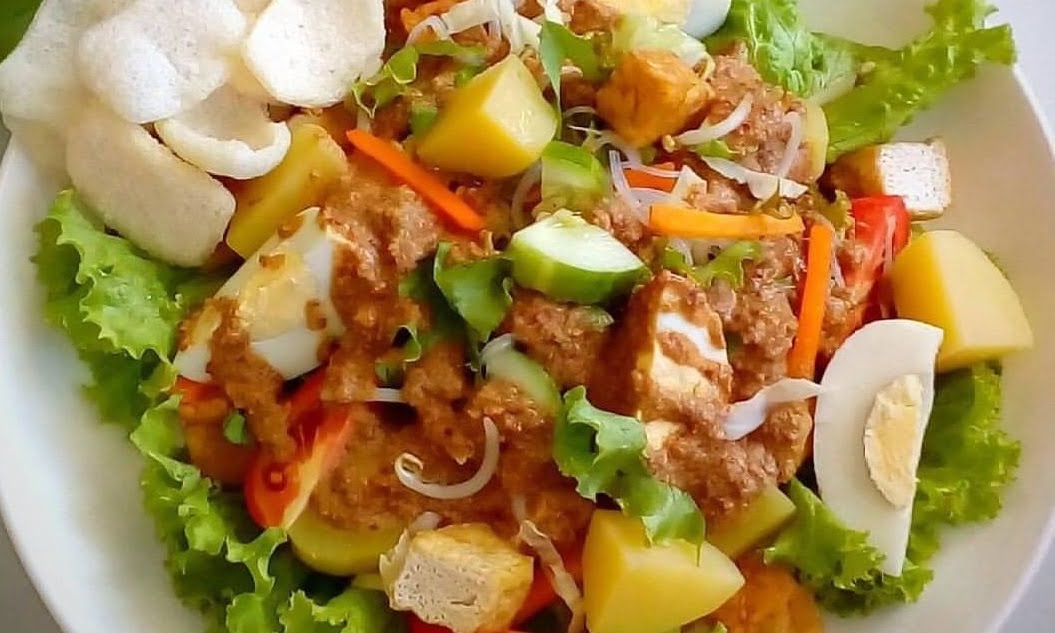 © Wikimedia.org/Piknikdong, CC BY-SA
© Wikimedia.org/Piknikdong, CC BY-SA
Nasi goreng (English pronunciation: /ˌnɑːsi ɡɒˈrɛŋ/) is a Southeast Asian fried rice dish, usually cooked with pieces of meat and vegetables. One of Indonesia's national dishes, it is also eaten in Malay-speaking communities in countries such as Malaysia, Singapore and Brunei, and has gained popularity in Sri Lanka through migrations from the Malay Archipelago, in countries like Suriname via Indonesian immigrant communities, and in the Netherlands through its colonial ties with Indonesia. Nasi goreng is distinguished from other Asian fried rice preparations by its distinct smoky aroma, and caramelised yet savoury undertones of flavour. There is no single defined recipe for nasi goreng, and its composition and preparation varies greatly from household to household. Nasi goreng has long been considered an important staple of Indonesian cuisine. In 2018, it is officially recognized by the Indonesian government as one of the country's five national dishes. (Source: Wikipedia.org, CC BY-SA)
Rendang (/ˈrəndɑːŋ/ REN-DUNG; Indonesian pronunciation: [rənˈdaŋ]) is a Minang dish originating from the Minangkabau region in West Sumatra, Indonesia. It has spread across Indonesian cuisine to the cuisines of neighbouring Southeast Asian countries such as Malaysia, Singapore, Brunei and the Philippines. Rendang is often described as a rich dish of meat — most commonly beef (rendang daging) — that has been slow cooked and braised in a coconut milk seasoned with a herb and spice mixture, until the liquids evaporate and the meat turns dark brown and tender, becoming caramelized and infused with rich flavours. Rendang is officially recognised as one of Indonesia's national dishes. Six types of rendang preparations have also been designated as intangible cultural heritage by the Indonesian Ministry of Education and Culture. A broad survey in 2011 placed beef rendang as the most delicious dish in the world. (Source: Wikipedia.org, CC BY-SA)
Satay (/ˈsɑːteɪ/ SAH-tay, in USA also /sɑːˈteɪ/ sah-TAY, /sæˈteɪ/ sa-TAY), or sate in Indonesian spelling, is a Southeast Asian dish of seasoned, skewered and grilled meat, served with a sauce. The earliest preparations of satay is believed to have originated in Java island, but has spread to almost anywhere in Indonesia, where it has become a national dish. Indonesian satay is often served with peanut sauce – a sauce made from peanut butter, and is often accompanied with lontong, a type of rice cake, though the diversity of the country has produced a wide variety of satay recipes. It is also popular in many other Southeast Asian countries including Brunei, Malaysia, Philippines, Singapore and Thailand. It is also recognized and popular in Suriname and the Netherlands. In Sri Lanka, it has become a staple of the local diet as a result of the influences from the local Malay community. (Source: Wikipedia.org, CC BY-SA)
Soto (also known as sroto, tauto, saoto, or coto) is a traditional Indonesian soup mainly composed of broth, meat, and vegetables. Many traditional soups are called soto, whereas foreign and Western influenced soups are called sop. Soto is sometimes considered Indonesia's national dish, as it is served from Sumatra to Papua, in a wide range of variations. Soto is omnipresent in Indonesia, available in many warungs and open-air eateries on many street corners, to fine dining restaurants and luxurious hotels. Soto, especially soto ayam (chicken soto), is an Indonesian equivalent of chicken soup. Because it is always served warm with a tender texture, it is considered an Indonesian comfort food. Because of the proximity and significant numbers of Indonesian migrants working and settling in neighbouring countries, soto can also be found in Singapore and Malaysia, and has become a part of their cuisine. (Source: Wikipedia.org, CC BY-SA)
Tumpeng (Javanese: ꦠꦸꦩ꧀ꦥꦼꦁ; Balinese: ᬢᬸᬫ᭄ᬧᭂᬂ) is an Indonesian cone-shaped rice dish with side dishes of vegetables and meat originating from Javanese cuisine of Indonesia. Traditionally featured in the slamatan ceremony, the rice is made by using a cone-shaped woven bamboo container. The rice itself may be plain steamed rice, uduk rice (cooked with coconut milk), or yellow rice (uduk rice colored with kunyit (turmeric)). The rice cone is erected in the tampah (rounded woven bamboo container), covered with a banana leaf, and surrounded by assorted Indonesian dishes. In 2013, the Indonesian Ministry of Tourism and Creative Economy promoted tumpeng as one of 30 Indonesian culinary icons and gave it the status of official national dish of Indonesia in 2014, describing it as 'the dish that binds the diversity of Indonesian various culinary traditions.' (Source: Wikipedia.org, CC BY-SA)
 © Wikimedia.org/Mokkie, CC BY-SA
© Wikimedia.org/Mokkie, CC BY-SA
Abgoosht (Persian: آبگوشت Âbgušt, pronounced [ɒːbˈɡuːʃt]; literally 'meat broth') is an Iranian stew. It is also called dizi (Persian: دیزی, pronounced [diːˈziː]), which refers to the traditional stoneware crocks it is served in. Some describe it as a 'hearty mutton Persian soup thickened with chickpeas.' Ābgoosht is usually made with lamb, chickpeas, white beans, onion, potatoes, tomatoes, turmeric, and dried lime. Other variations exist in the beans used, such as kidney beans and black-eyed peas. The ingredients are combined and cooked until done, at which point the dish is strained. The solids are mashed as gusht kubideh (Persian: گوشت کوبیده, literally 'mashed meat') and served with the broth, but in a separate dish, along with flatbread. The popular Azerbaijani dish piti is a variety of abgoosht and encompasses many similar dishes in the region. (Source: Wikipedia.org, CC BY-SA)
Chelow kabab (Persian: چلوکباب čelow-kabāb [tʃelowkæˈbɒːb]) is an Iranian dish consisting of steamed rice (čelow) and one of the many varieties of Iranian kebab. It is considered the national dish of Iran, and was probably created by the time of the Qajar dynasty. Chelow kebab is served with accompaniments such as butter, sumac powder, basil, onions, and grilled tomatoes. The traditional beverage accompanied with chelow kebab is doogh, an Iranian yogurt-based drink, sometimes made of carbonated water. In the old bazaar tradition, the rice and accompaniments are served first, immediately followed by the kababs, which are threaded on skewers, as well as a piece of flat bread (typically lavash). A skewer is placed directly on the rice and while holding the kabab down on the rice with the bread, the skewer is quickly pulled out. (Source: Wikipedia.org, CC BY-SA)
Fesenjān (Persian: فسنجان; also called fesenjoon in Tehrani dialect) is a sweet and sour Iranian stew (a khoresh) from Northern Iran. It is typically served over rice in the Iranian manner. Like other khoresh stews served over rice, fesenjan is common also to Iraqi cuisine. As a festive dish for special occasions, it has become part of Jewish Rosh Hashannah celebrations. Even though the typology of Jewish ethnic cuisines is imprecise, fesenjan may be considered part of Sephardic cuisine. In Azerbaijan, where it called fisincan plov, the stew is made with lamb meatballs instead of poultry. (Source: Wikipedia.org, CC BY-SA)
Ghormeh sabzi (Persian: قورمه سبزی) or Khoresht sabzi (Persian: خورشت سبزی), also spelled qormeh sabzi, is an Iranian herb stew. It is considered the national dish of Iran. It is a very popular dish in Iran. The main ingredients are a mixture of sauteed herbs, consisting mainly of parsley, leeks or green onions, and coriander, seasoned with the key spice of dried fenugreek leaves. The herb mixture has many variations. Any dark bitter greens can be used, such as kale, mustard greens, or turnip greens, although none are part of the original recipe. This mixture is cooked with kidney beans, yellow or red onions, black lime (pierced dried limou-Amani Persian lime), and turmeric-seasoned lamb or beef. The dish is then served with polo (Persian parboiled and steamed rice) or over tahdig. The Financial Times noted that there is much disagreement among Iranians on the ingredients used in the stew. (Source: Wikipedia.org, CC BY-SA)
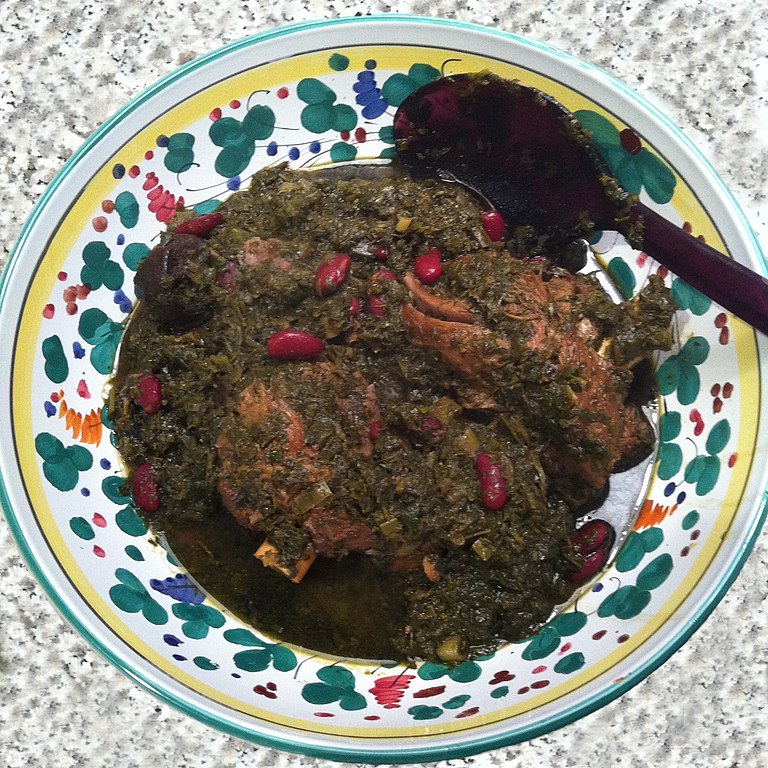 © Wikimedia.org/Amin Majidi, CC0
© Wikimedia.org/Amin Majidi, CC0
Masgouf (Arabic: المسكوف), is a Mesopotamian dish consisting of seasoned, grilled carp; it is often considered the national dish of Iraq. The Iraqi capital city Baghdad prides itself on making the best masgouf, with the Abu Nawas district on the shores of the Tigris river, 'dedicated' to this dish. Nonetheless, one can find masgouf all over Iraq, especially near the Tigris-Euphrates Basin. Outside of Iraq, masguf is more or less popular eastern parts of Syria, especially in the regions bordering Iraq, such as in the Raqqa Governorate, which is crossed by the Euphrates. It is also seen, at a lesser scale, Turkey, such as Nusaybin and Cizre, on the Iraqi border. (Source: Wikipedia.org, CC BY-SA)
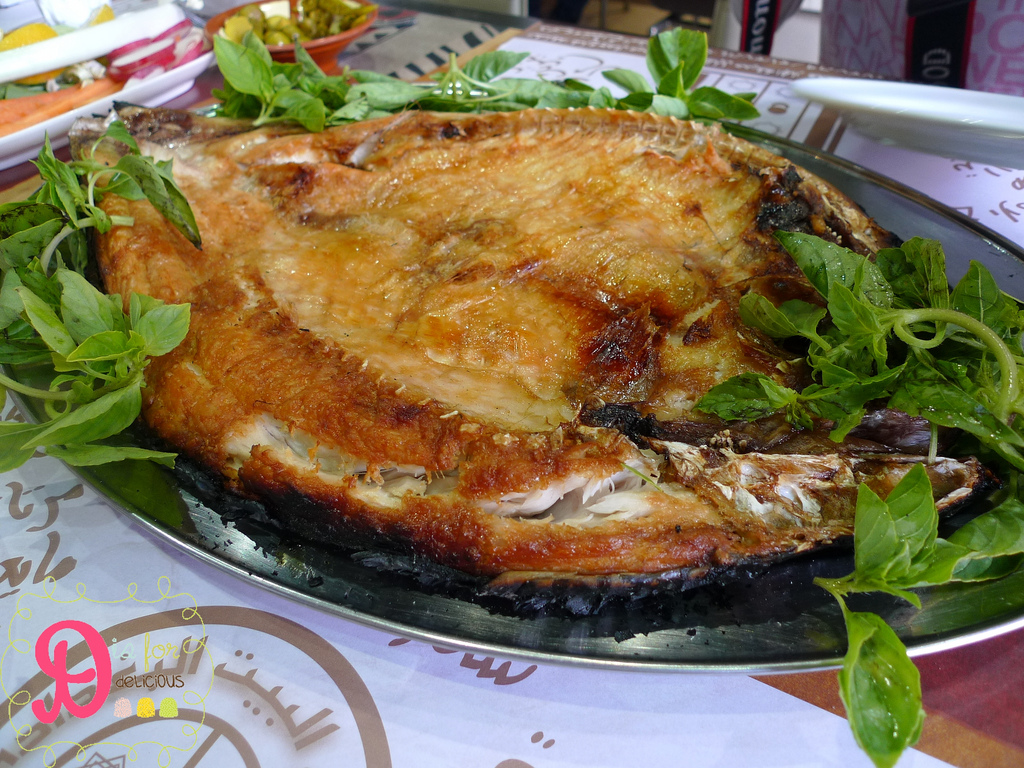 © Wikimedia.org/Hill93, CC BY-SA
© Wikimedia.org/Hill93, CC BY-SA
Quzi (Arabic: قوزي), also spelled as qoozi or ghoozi, is a rice-based dish popular and is considered as one of Iraq's national dishes. It is served with very slowly cooked lamb, roasted nuts, and raisins served over rice. The dish was introduced into Turkey by Syrian immigrants.[citation needed] The dish can also be found in some Arab states of the Persian Gulf.[citation needed] In Iraqi cuisine, it is usually prepared by stuffing a whole lamb with rice, vegetables, spices and nuts and slow-cooking it over a closed or submerged oven. In some places in the Middle East it is buried in a pit containing burning coal or charcoal to get the smoky flavor. (Source: Wikipedia.org, CC BY-SA)
The breakfast roll (Irish: rollóg bhricfeasta, [ˈɾˠoːl̪ˠoːɡ ˈvʲɾʲɪcˌfʲasˠt̪ˠə]) is a bread roll filled with elements of a traditional fried breakfast. It is served at a wide variety of convenience shops, newsagents, supermarkets, petrol stations, and casual eateries throughout Ireland. A breakfast roll typically consists of a bread roll or baguette containing one or more fillings such as sausages, bacon, white or black pudding, butter, mushrooms, tomatoes and tomato sauce or brown sauce. In some cases a hash brown or fried egg may be added; these fillings vary between cooks and restaurants. The roll itself is usually one of three varieties: a soft 'submarine'-type roll, a chunky, spherical dinner roll or a demi-baguette. The demi-baguettes are distributed to shops partially baked and frozen, allowing stores to quickly bake the bread for a 'freshly baked' roll. An 'all-day breakfast' sandwich featuring some or all of the above ingredients in a traditional sandwich of sliced bread may be used instead.[citation needed] (Source: Wikipedia.org, CC BY-SA)
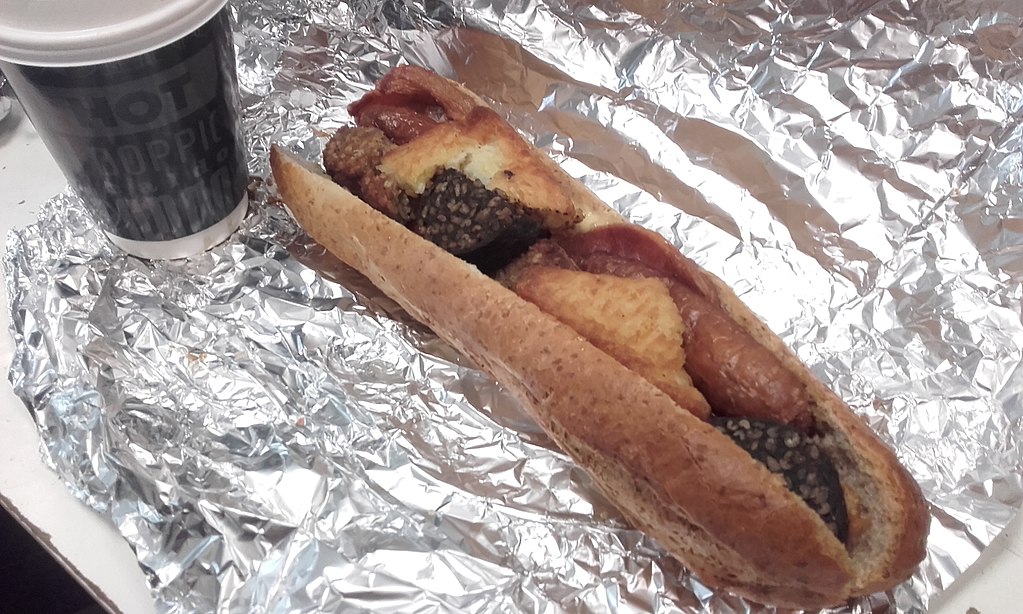 © Wikimedia.org/Charlesolivercork, CC BY-SA
© Wikimedia.org/Charlesolivercork, CC BY-SA
Irish stew (Irish: stobhach/Stobhach Gaelach) is a stew native to Ireland that is traditionally made with root vegetables and lamb or mutton, but also commonly with beef. As in all traditional folk dishes, the exact recipe is not consistent from time to time, or place to place. Basic ingredients include lamb, or mutton (mutton is used as it comes from less tender sheep over a year old, is fattier, and has a stronger flavour, and was generally more common in less-affluent times), as well as potatoes, onions, and parsley. It may sometimes also include carrots. Irish stew is also made with kid. (Source: Wikipedia.org, CC BY-SA)
Jerusalem mixed grill (Hebrew: מעורב ירושלמי) (me'orav Yerushalmi) is a grilled meat dish considered a specialty of Jerusalem. It consists of chicken hearts, spleens and liver mixed with bits of lamb cooked on a flat grill, seasoned with onion, garlic, black pepper, cumin, turmeric, olive oil and coriander. The dish is said to have been invented at the Mahane Yehuda Market, with various restaurants claiming to be the originators. In 2009, Israeli chefs created a giant portion that weighed in at 440 pounds (200 kilos), winning a Guinness world record for the largest Jerusalem mixed grill. They also prepared the world's smallest dish: Jerusalem mixed grill in a pita the size of a coin. (Source: Wikipedia.org, CC BY-SA)
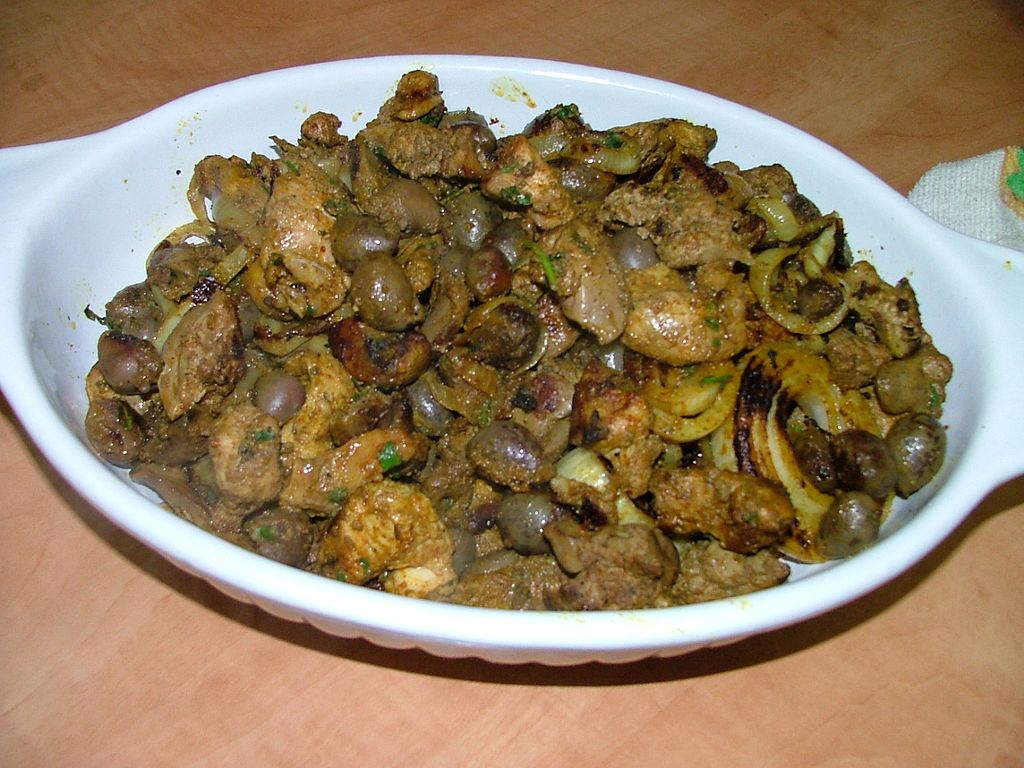 © Wikimedia.org/Peterjerusalem, CC BY-SA
© Wikimedia.org/Peterjerusalem, CC BY-SA
Shakshouka (Arabic: شكشوكة : šakšūkah, also spelled shakshuka or chakchouka) is a Maghrebi dish of eggs poached in a sauce of tomatoes, olive oil, peppers, onion, and garlic, commonly spiced with cumin, paprika and cayenne pepper. According to Joan Nathan, shakshouka originated in Ottoman North Africa in the mid-16th century after tomatoes were introduced to the region by Hernán Cortés as part of the Columbian exchange. In Jewish culture, a large batch of tomato stew is made for the Sabbath dinner and the leftovers used the following morning to make a breakfast shakshouka with eggs. In Andalusian cuisine, the dish is known as huevos a la flamenca; this version includes chorizo and serrano ham. in Italian cuisine, there is a version of this dish called uova in purgatorio (eggs in purgatory) that adds tomato paste, anchovy, garlic, basil or parsley, and sometimes parmesan cheese. (Source: Wikipedia.org, CC BY-SA)
Pasta (US: /ˈpɑːstə/, UK: /ˈpæstə/; Italian pronunciation: [ˈpasta]) is a type of food typically made from an unleavened dough of wheat flour mixed with water or eggs, and formed into sheets or other shapes, then cooked by boiling or baking. Rice flour, or legumes such as beans or lentils, are sometimes used in place of wheat flour to yield a different taste and texture, or as a gluten-free alternative. Pasta is a staple food of Italian cuisine. Pastas are divided into two broad categories: dried (pasta secca) and fresh (pasta fresca). Most dried pasta is produced commercially via an extrusion process, although it can be produced at home. Fresh pasta is traditionally produced by hand, sometimes with the aid of simple machines. Fresh pastas available in grocery stores are produced commercially by large-scale machines. (Source: Wikipedia.org, CC BY-SA)
Pizza (English: /ˈpiːtsə/ PEET-sə, Italian: [ˈpittsa], Neapolitan: [ˈpittsə]) is a dish of Italian origin consisting of a usually round, flat base of leavened wheat-based dough topped with tomatoes, cheese, and often various other ingredients (such as various types of sausage, anchovies, mushrooms, onions, olives, vegetables, meat, ham, etc.), which is then baked at a high temperature, traditionally in a wood-fired oven. A small pizza is sometimes called a pizzetta. A person who makes pizza is known as a pizzaiolo. In Italy, pizza served in a restaurant is presented unsliced, and is eaten with the use of a knife and fork. In casual settings, however, it is cut into wedges to be eaten while held in the hand. (Source: Wikipedia.org, CC BY-SA)

Time for recess! Post a comment, ask a question or write a review. Feel free to let us know what you think!
Vwb borden verkeersplein en rotonde slaat U hier de plank behoorlijk mis. Mag wel eens aangepast worden. Jammer.
ABS Nedir Nasıl Çalışır ? - https://www.diskfren.com/abs-nedir-nasil-calisir.html
Driving whit a tractor possible? What are the requirements? Can i drive whit a dutch T-licence?
Tot waar geldt een verkeersbord? In België is dat tot het volgende kruispunt, in Spanje lijkt het verder te reiken.
Waar kan ik het bord vinden, einde werk in uitvoering. Er staat dan een schuine streep er door.
Waar kan ik hetbord vinden, einde werk in uitvoering. Er staat dan een schuine streep er door.
بعضی سوالها طوری ترراهی شده ذهن مراجعین رامختل می کند.تااینکه معلومات را اضافه کند
Bij ons staat in het park een bord rond met een poepende hond erop is dat een verbodsbord of een opmerkings bord ? Ze laten de honden poepen en lopen gewoon lekker door kan dat zo maar ???
ik wil met kleine aanhanger zonder eigen kenteken naar de oekraine kan dat ,zonder probleem
Instructies onduidelijk, ben met verkeersbord tegen auto aangereden (geintje). Ik had wel wat aan de random test, truckje dat mij enorm hielp is een patroon ontdekken in de vorm en kleur van bord en en aangegeven symbool, dan kun je het juiste antwoord meestal wel raden,ook als je niet zeker bent.
Oei ! Ik dacht hier de Thaise wegcode te vinden in het NL ? Blijkbaar mis ? Iemand een LINK waar ik dat wel kan vinden, Thaise wegcode met verkeersborden en info in het Nederlands? Mag altijd gestuurd worden ...
Beste student! Op deze pagina proberen we u iets bij te leren over de verkeersregels. Laat ons weten wat u ervan vindt!